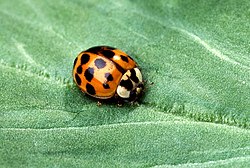Talk:List of kigo
| This article is rated List-class on Wikipedia's content assessment scale. It is of interest to the following WikiProjects: | |||||||||||||||||||||||||||||||
| |||||||||||||||||||||||||||||||
To Do list
[edit]
Done[edit]
To Do[edit]
Final goal[edit]
|
Ume blossom photos
[edit]
Image:Ume.jpg New photo - Plum blossoms (ume), one of the many different flowers used as spring kigo
- Image:Plum_flowers.jpg shows plum blossoms, not ume blossoms. The flower stalks are too long to be ume. Image:Ume.jpg shows ume blossoms. --163.139.215.193 16:00, 10 Jun 2005 (UTC)
Gallery of photos for possible use in the list of kigo
[edit]













Scope of this article?
[edit]In the absence of any indication to the contrary, it seems reasonable to assume that this "list of kigo" should ideally be a complete list. It should be made clear in the lead, in accordance with Wikipedia:Lists#Lead_section_or_paragraph, just what the scope of the list is. If it is indeed the aim to make a complete list, then this is much complicated (and perhaps rendered impossible) by the inclusion of "international kigo" as well as Japanese ones. While there is a large number of Japanese kigo, most of which are clearly defined as to their seasonality, to list them would perhaps not be a superhuman task; but once the task is widened to include "all international kigo", then its feasibility must be called into question. A spring phenomenon in one place is a summer one in another; there are innumerable culturally-specific season-signifiers around the globe; climate in many parts is not neatly arranged into four seasons on the Japanese model.
At the moment the article seems to be neither one thing nor another. If the aim of this article is not to be an exhaustive list (even of just Japanese kigo), then its reason for existing may be questionable. There is already a representative sample of Japanese kigo in the kigo article.
I'd appreciate if editors interested in this article joined the discussion. Thanks. --Yumegusa (talk) 13:08, 23 March 2009 (UTC)
- I agree. A list of "seasonal words" or something seems fine, but "non-Japanese kigo" seems a bit odd. Kigo is a Japanese concept related to the use of words in haiku. In English, iIt's not a general term for words associated with seasons all over the world. This article seems quite flawed to me too. Cheers, Nesnad (talk) 03:41, 10 July 2009 (UTC)
- I agree too. Rosebowl parade? Dominion day? These are not kigo-related. Exploding Boy (talk) 23:45, 28 February 2010 (UTC)
- Okay, in view of the consensus expressed, I'll start excising references to non-Japanese items from the article. The question remains whether this "list" is a viable article, even if it deals only with Japanese kigo. --Yumegusa (talk) 01:03, 1 March 2010 (UTC)
Merge?
[edit]Kigo already includes a list of kigo, and WP:NOTDICTIONARY says we shouldn't have independent pages that simply list words. elvenscout742 (talk) 14:11, 31 December 2012 (UTC)




